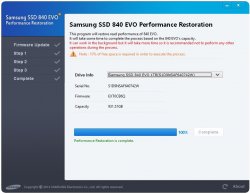I have a Samsung 1TB 840 evo pro SSD that indeed exhibits the issue with slow copies of older data. It is the boot (and only) drive in my 2012 Mac Mini.
Now that I have some free time, I cloned the drive this morning to an external drive using CCC.
I downloaded the Samsung firmware updater for Mac and burned the ISO to a CD using an external USB DVD drive on the Mini. I restarted the Mini holding down the ALT (Option) key and one of the choices presented was to boot to "Windows" with a CD icon.
I chose that option and the CD drive read for a few seconds (the updater is only 3MB), I get a flashing white cursor on the top left of a black screen. It's been that way for 45 minutes now.
In the Samsung documentation - there's a troubleshooting question that says "Why does the Samsung SSD Firmware Update application take so long to open?" with the answer "The Firmware Update application tries to detect all disks connected to the system upon launch. This may require a few minutes, depending on the number of disks connected to the system and the hardware platform."
My questions are - has anyone used this boot software to update and is 45 minutes long enough to wait that it's obviously not going to work for me?
I only have the SSD boot drive and a firewire external (time machine) drive connected to the system.....it shouldn't be taking this long to find the Samsung drive in my opinion. Thoughts???
Now that I have some free time, I cloned the drive this morning to an external drive using CCC.
I downloaded the Samsung firmware updater for Mac and burned the ISO to a CD using an external USB DVD drive on the Mini. I restarted the Mini holding down the ALT (Option) key and one of the choices presented was to boot to "Windows" with a CD icon.
I chose that option and the CD drive read for a few seconds (the updater is only 3MB), I get a flashing white cursor on the top left of a black screen. It's been that way for 45 minutes now.
In the Samsung documentation - there's a troubleshooting question that says "Why does the Samsung SSD Firmware Update application take so long to open?" with the answer "The Firmware Update application tries to detect all disks connected to the system upon launch. This may require a few minutes, depending on the number of disks connected to the system and the hardware platform."
My questions are - has anyone used this boot software to update and is 45 minutes long enough to wait that it's obviously not going to work for me?
I only have the SSD boot drive and a firewire external (time machine) drive connected to the system.....it shouldn't be taking this long to find the Samsung drive in my opinion. Thoughts???


